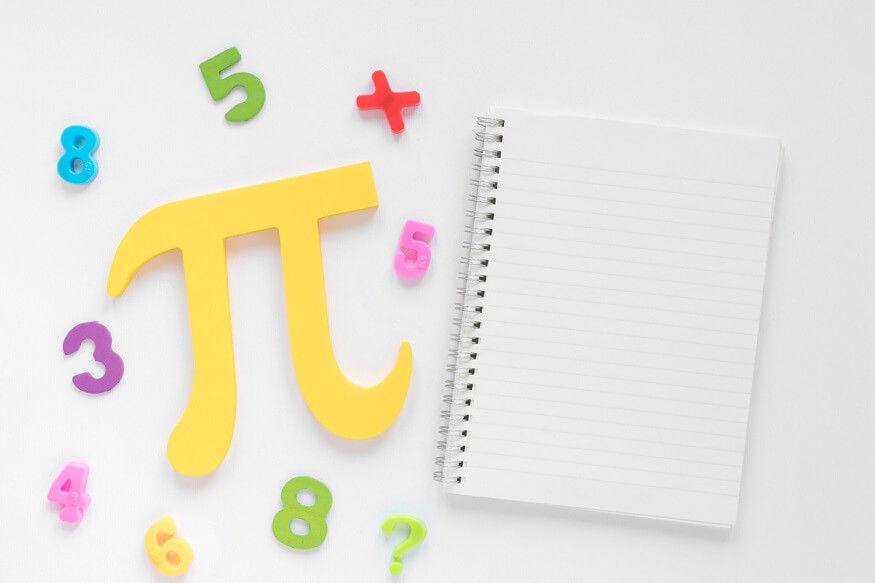Pi, represented by the Greek letter π, is one of the most famous constants in mathematics and is the ratio of a circle’s circumference to its diameter. It is an irrational number, meaning it cannot be expressed as a fraction of two integers. Its decimal representation is infinite and non-repeating, with its value approximately equal to 3.14159. Since Pi is such a unique and important number, there is an entire day dedicated to it: Pi Approximation Day.
Also Read: Top 10 Ways to Utilise Maths Formulas in Day-to-Day Life
What is Pi?
Pi is the symbol used in mathematics to represent a constant — the ratio of the circumference of a circle to its diameter — which is approximately 3.14159. It has been known for almost 4000 years, and its symbol (π) was adopted for the number in the 18th century thanks to Euler, an influential mathematician. Pi is an irrational number, meaning it has an infinite number of decimal places, and cannot be represented exactly as a fraction. It is also a transcendental number, which means that it is not the root of any non-zero polynomial equation with rational coefficients.
Also Read: Why Studying Maths is Important for Children
What is the value of Pi?
The value of Pi is approximately 3.14159, although it is often simplified to 3.14 for calculations. The true value of Pi has been calculated to over one trillion digits beyond its decimal point, but only a handful of those digits are needed for most practical calculations. The value of Pi has fascinated mathematicians for centuries because of its infinite and seemingly random sequence of digits.
Pi Approximation Day History
Pi Approximation Day is celebrated on 22 July (22/7 in the day/month format), because 22 divided by 7 is a common approximation of Pi (3.1428571…). This makes it a fun and accessible way to celebrate this famous mathematical constant. Another day dedicated to Pi is Pi Day, which is celebrated on March 14th (3/14 in the month/day format), as the date represents the first three digits of Pi.
Despite the fact that the idea of Pi has been understood for approximately 4,000 years, Pi Approximation Day is a relatively new holiday. It was developed by math lovers who wanted to have some fun and lightheartedly recognise the significance of Pi. Today, math enthusiasts, educators, and students alike observe the day all across the world.
Also Read: Who invented Zero First: History and Facts
Pi Approximation Day Significance
Pi is a key mathematical constant that is utilised in a number of computations involving circles, including calculating the circumference, area, and volume of spherical objects. Numerous other branches of mathematics and science, such as trigonometry, calculus, statistics, and physics, also use it. Pi Approximation Day is a significant occasion to commemorate and spread knowledge about the significance of this unusual number.
The commemoration of Pi Approximation Day emphasises the value of approximation in both mathematics and everyday life. Approximations are used to produce results that are close enough to be useful when solving many mathematical problems that cannot be solved precisely. In disciplines like engineering, physics, and computer science, this is especially crucial.
Also Read: What is Vedic Maths: Meaning, Importance and Usage
Pi day vs Pi Approximation day
Pi Day and Pi Approximation Day are two celebrations dedicated to the most famous constant in mathematics, π (Pi). Pi is the ratio of a circle’s circumference to its diameter and is approximately equal to 3.14159. However, its decimal representation goes on forever and does not repeat, making it an irrational number.
Pi Day is celebrated on 14th March (3/14 in the American date format), as the first three digits of Pi are 3.14. This day is often marked by various activities such as pie-eating contests, discussions about the significance of Pi, and even recitations of its many decimal places. In 2009, the United States House of Representatives even passed a resolution officially recognising 14th March as National Pi Day.
On the other hand, Pi Approximation Day is celebrated on 22nd July (22/7 in the day/month format), as 22/7 is a common approximation of Pi. While it is not as widely recognised as Pi Day, it is still celebrated by mathematics enthusiasts and educators around the world. Activities on Pi Approximation Day may include exploring different ways to approximate Pi, discussing the history of Pi, and its significance in various mathematical calculations.
Both Pi Day and Pi Approximation Day serve as excellent opportunities to celebrate mathematics and its importance in our daily lives. Whether you choose to celebrate by eating pie, discussing the fascinating history of Pi, or by exploring its many applications, take a moment to appreciate the beauty and significance of this incredible number.
How to Celebrate Pi Approximation Day
There are various ways to celebrate Pi Approximation Day, both fun and educational:
Bake a Pie: This is a fun and popular way to celebrate Pi Approximation Day. You can bake a pie and decorate it with the Pi symbol or the digits of Pi. Children can learn a lot from this opportunity about the importance of Pi and its value.
Pi Memorisation Contest: Challenge yourself or others to memorise as many digits of Pi as possible. This is a fun way to engage with the number and test your memory skills.
Pi Art: Create artwork inspired by Pi. This could be a drawing, painting, or digital artwork that incorporates the Pi symbol or the digits of Pi.
Pi Run: Organise a run or walk of 3.14 miles (or kilometres) to celebrate the value of Pi.
Pi Games: Play games or solve puzzles that involve the use of Pi. For example, you could solve problems related to the circumference or area of circles, or play a game that involves calculating the volume of circular objects.
Educational Activities: On Pi Approximation Day, teachers can incorporate pi-related activities into their lessons. This could result in figuring out circle-related puzzles or researching the background and significance of Pi.
Also Read: 12 Key Benefits of Learning Abacus for Student
EuroSchool amalgamates education with fun and makes sure our students learn and enjoy at the same time.










